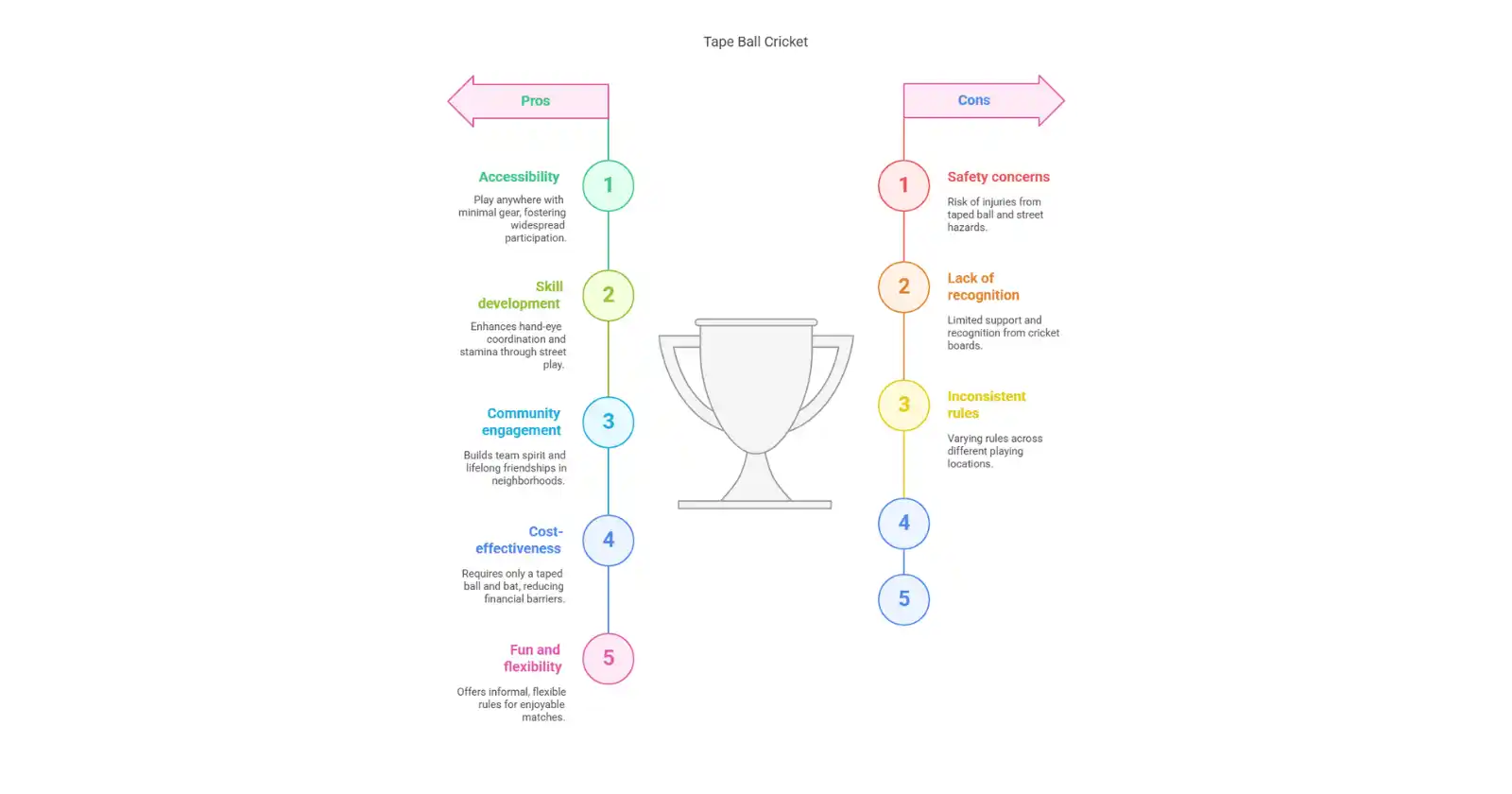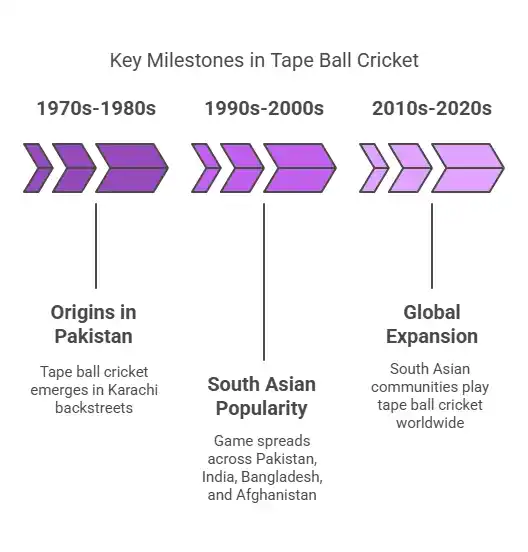What Is Tape Ball Cricket? Fun Facts & Tape Ball

What is tape ball cricket and why are so many obsessed with it?
As someone who treats cricket gear like collectibles. Trust me this isn’t your average backyard game. It’s a vibe.
What is Tape Ball Cricket?
Tape ball cricket is the street traditional cricket. Instead of a hard leather ball, it uses a tennis ball tightly wrapped with electrical tape to make it faster, bouncier and safe. It’s the DIY cricket format played in streets, alleys, parks. No pads, no helmets, just pure passion.
How Tape Ball Cricket Got Its Name?
Simple, take a tennis ball, wrap it in black electrical tape and boom, you’ve got a “tape ball.” The tape adds weight and speed and feels like a leather ball. This little innovation gave birth to an entire cricket subculture.

History and Origins Tape Ball Cricket
Tape ball cricket began in the 1970s and 80s, mostly in the backstreets of Pakistan where cricket was life but budgets were tight. Kids needed a cheaper, safer way to play hard-hitting cricket. So they got creative. Discover the tape ball cricket.
Growth in South Asia and Beyond
From Karachi to Kolkata, tape ball cricket is the most famous cricket game. It became popular in Pakistan, India, Bangladesh and even Afghanistan. You’ll find late-night games under streetlights, rooftop tournaments and any open field with some lighting. Today, it’s spread across the world, with South Asian communities playing it in the UK, UAE, USA and beyond.
Equipment Used in Tape Ball Cricket
Now, don’t expect a full Test-match setup. Tape ball cricket is all about that tennis ball wrapped in black tape. It swings, it skids, it stings (just enough). Pair it with a sturdy lightweight wooden bat and you’re good to go. And yes, someone always brings a backup tape roll because halfway through, that ball starts to look like it’s been torn up.
Bat, Stumps, and Other Essentials
You don’t need high-end gear to get started. The bat is usually lighter than the one used in pro cricket, for faster swings and sixes. Stumps? Plastic ones if you’re fancy, bricks or chairs are also common. No pads, gloves or helmets are needed.
Differences from Traditional Cricket Gear
Let’s be real, traditional cricket gear are not needed. No leather ball, no need for full protective gear and no long innings. It’s fast-paced, just more fun and way louder.

Rules and Format of the Game
Rules? Sure. But also, house rules. Every street, park and rooftop has its own version. Matches are usually short—5 to 10 overs per side. No third umpires, no reviews. It’s informal & flexible. And yes, you’re out if the ball hits the electric pole.
Common Rules in Tape Ball Matches
- LBW? Mostly ignored.
- No-balls? If someone oversteps by a mile, maybe.
- Wickets? Clean bowled, caught or run-out are standard.
- Boundaries? If it hits the wall, it’s four. Over the wall? That’s six (or out, depending on whose window broke).
- Run limits? If the field’s tiny, one-run max rules often apply.
Every match feels like a mix of cricket and lots of fun.
Match Duration and Scoring
If you think Test matches are too long and T20 is just about right then tape ball cricket laughs in both their faces. Most matches last 5 to 10 overs per side, perfect for quick matches. Scoring?
Batsmen swing like there’s no tomorrow, and bowlers go for all in power in every ball. It’s fast forward cricket with shouting & running.
Field Setup and Player Roles
Fields are whatever space you can find. Street? Rooftop? Parking lot?
Absolutely. Boundaries are usually “from this wall to that brick mark” and fielder positions are strategic. You’ve got your good fielder and the kid who only wants to bat. Roles shift fast, especially when someone has to leave early for dinner or their mom yells from the balcony.
Popularity and Cultural Impact
In South Asia, it’s where future stars are born. It’s the original networking between kids cricket fans. It’s on streets, makes school memories, and even in wedding-day matches (yes, really).

Why Tape Ball Cricket Is So Popular?
It’s cricket but without the red tape . It’s cheap, fast and doesn’t require a giant stadium. All you need is a taped ball, a bat and some people with opinions. No gear rentals, no formal teams. It’s addictive.
Comparison with Hard Ball Cricket
Think of tape ball cricket as the street version of hard ball cricket. It’s like comparing pickup basketball to the NBA. Both have their charm, but tape ball gives you freedom to play your way without needing a full kit or five hours.
Differences in Playing Style
You’ll see helicopter shots, reverse sweeps and scoops way before a coach would approve. Hard ball cricket demands discipline. But a tape ball match is wild & unpredictable.
Safety and Accessibility
Safety-wise, tape ball wins. No pads required. It’s kid-friendly, uncle-friendly and playable in shorts and slippers. Anyone with a ball, a bat and some tape can start a match. No pitch? No problem.
Transitioning from Tape Ball to Professional Cricket
Many big names in cricket like Pakistan’s Mohammad Amir and Hasan Ali started with tape ball matches in dusty lanes.
Sure, transitioning to pro cricket means adapting technique-heavy formats, but tape ball gives fearless confidence.

Benefits of Playing Tape Ball Cricket
It improves hand-eye coordination and builds stamina. You learn to develop your own style. And you do it all while surrounded by friends with enough time.
Physical Fitness and Skill Development
Running on streets, concrete, and batting under pressure tape ball cricket is the best. It’s perfect for building foundational cricket skills.
Community Engagement and Team Spirit
Ask anyone who’s played, and they’ll tell you. It’s about bonding and that sweet team spirit. It brings neighborhoods together, starting off lifelong friendships and turns strangers into teammates. Someone’s always grilling corn or selling cold drinks nearby.
Challenges
Tape ball cricket isn’t possible with that one guy who brings a cracked bat. But there are bigger challenges, inconsistent rules, lack of formal structure and limited support for players.
Safety Concerns
Sure, it’s safer than hard ball cricket, but let’s not pretend it’s injury-proof. That taped-up ball hurts when it hits you right. Plus, playing on streets means dodging bikes, cars and the occasional stray dog. No helmets, no gloves, just guts.
Lack of Formal Recognition
Tape ball cricket gets treated like no one takes it seriously. There’s no real league system, no formal coaching and little support from cricket boards. But here’s the irony, many pro cricketers start from this tape ball street mathes.
At The End
So, what is tape ball cricket, really? It’s more than a taped-up ball, it’s passion, banter and boundary. Whether you’re a rookie or a retired street legend, this version of cricket keeps the spirit. See our more articles about cricket.

